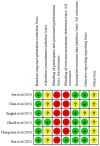Isokinetic Muscle Strengthening of the Lower Limbs in People with Stroke: A Systematic Review of Randomized Controlled Trials
- PMID: 40217666
- PMCID: PMC11989997
- DOI: 10.3390/jcm14072215
Isokinetic Muscle Strengthening of the Lower Limbs in People with Stroke: A Systematic Review of Randomized Controlled Trials
Abstract
Introduction: Muscle weakness is one of the main consequences following a stroke, leading to significant alterations in gait and other daily activities. Isokinetic muscle strengthening of the lower limb is considered to be an effective complement to conventional treatment to improve these functional limitations. The objective of this systematic review was to analyze isokinetic lower limb strengthening protocols and their effects on muscle strength, gait, and mobility in post-stroke patients compared to conventional physiotherapy or other strengthening methods. Methods: A systematic review of randomized controlled trials (RCTs) from the last 10 years was conducted. Studies analyzing the effects of isokinetic lower limb muscle strengthening compared to conventional physiotherapy or other strengthening methods on muscle strength, gait parameters, and mobility in post-stroke adults were selected. The quality and risk of bias of the studies were evaluated using the PEDro scale, the Oxford Level of Evidence scale, and the Cochrane Review Manager tool. Results: Six studies met the eligibility criteria. For knee-ankle strength, gait speed, and mobility, isokinetic strengthening demonstrated significant improvements compared to conventional physical therapy. When compared to other strengthening methods, isokinetic training was more effective for hip-knee strength and mobility, while closed kinetic chain isokinetic strengthening showed greater benefits for gait speed. Additionally, in the early post-stroke phase, isokinetic training showed greater improvements, while the chronic phase demonstrated more variable results. The methodological quality of the studies was acceptable-good. Conclusions: Isokinetic muscle strengthening significantly improves muscle strength, gait speed, and mobility in post-stroke adults compared to conventional physical therapy, offering additional benefits over other strengthening methods. Further research is needed to evaluate its long-term effectiveness, optimize protocols, and explore the impact of treatment timing.
Keywords: gait; isokinetic muscle strengthening; isokinetic training; lower limb; stroke.
Conflict of interest statement
The authors declare no conflicts of interest.
Figures




Similar articles
-
Effects of isokinetic muscle strengthening on muscle strength, mobility, and gait in post-stroke patients: a systematic review and meta-analysis.Clin Rehabil. 2019 Mar;33(3):381-394. doi: 10.1177/0269215518815220. Epub 2018 Nov 28. Clin Rehabil. 2019. PMID: 30484329
-
Effects of the bilateral isokinetic strengthening training on functional parameters, gait, and the quality of life in patients with stroke.Int J Clin Exp Med. 2015 Sep 15;8(9):16871-9. eCollection 2015. Int J Clin Exp Med. 2015. PMID: 26629238 Free PMC article.
-
Necessity and Content of Swing Phase Gait Coordination Training Post Stroke; A Case Report.Brain Sci. 2021 Nov 12;11(11):1498. doi: 10.3390/brainsci11111498. Brain Sci. 2021. PMID: 34827497 Free PMC article.
-
Ballistic strength training compared with usual care for improving mobility following traumatic brain injury: protocol for a randomised, controlled trial.J Physiother. 2016 Jul;62(3):164. doi: 10.1016/j.jphys.2016.04.003. Epub 2016 Jun 16. J Physiother. 2016. PMID: 27320832 Clinical Trial.
-
Isokinetic muscle strengthening after acquired cerebral damage: a literature review.Ann Phys Rehabil Med. 2012 May;55(4):279-91. doi: 10.1016/j.rehab.2012.03.003. Epub 2012 Mar 27. Ann Phys Rehabil Med. 2012. PMID: 22503293 Review. English, French.
References
-
- Plaza I. Sociedad Española de Neurología. Grupo de Estudio de Enfermedades Cerebrovasculares de la SEN. Valencia: Sociedad Valenciana de Neurología, Instituto Médico Valenciano. 2006. El Ictus Manual. Capítulo 1: ¿qué es un ictus? [1 pantalla] [(accessed on 5 June 2024)]. Available online: http://ictus.sen.es/?page_id=25.
-
- National Institutes of Health United States: National Heart, Lung, and Blood Institute; 2023. What Is a Stroke? [(accessed on 15 October 2024)]; Available online: https://www.nhlbi.nih.gov/health/stroke.
-
- Cano-De-La-Cuerda R., Collado-Vázquez S. Neurorrehabilitación: Métodos Específicos de Valoración y Tratamiento. 1st ed. Médica Panamericana; Madrid, Spain: 2012.
-
- Ulla-Britt F., Downham D., Lexell J. Knee muscle strength, gait performance and perceived participation after stroke. Arch. Phys. Med. Rehabil. 2006;87:974–980. - PubMed
Publication types
LinkOut - more resources
Full Text Sources
Miscellaneous

